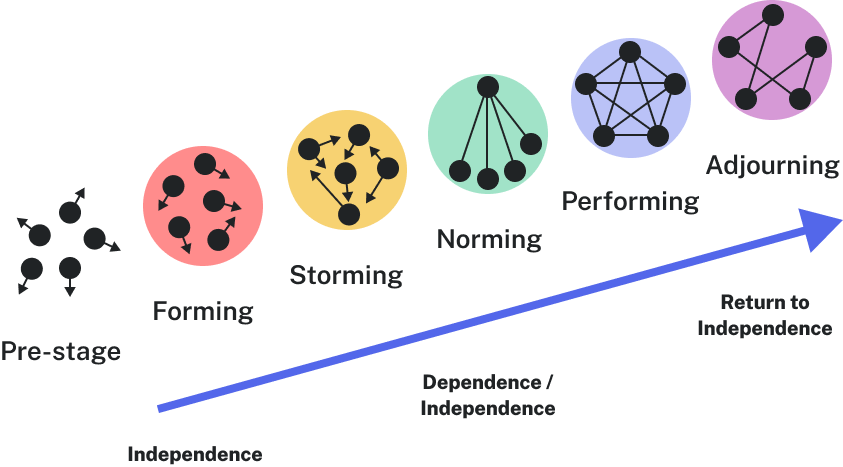Stages of Team Formation
team formation
The five stages of team formation are:
- forming
- storming
- norming
- performing
- adjourning
When teams develop, they move through a series of stages, beginning when they are formed and ending when they are disbanded. Bruce Tuckman identified the first four distinct stages of team development. He later added a fifth stage, adjourning, which is especially important for self-directed teams and project-based teams that form to reach a specific goal. Each stage has a primary purpose and a common set of interpersonal dynamics among team members. Tuckman proposed that all of these stages are inevitable and even necessary parts of a successful team’s evolution.

Forming Stage
The first step in a team’s life is bringing together a group of individuals. Individuals focus on defining and assigning tasks, establishing a schedule, organizing the team’s work, and other start-up matters. In addition to focusing on the scope of the team’s purpose and means of approaching it, individuals in the formation stage are also gathering impressions and information about one another. Since people generally want to be accepted by others, during this period they usually avoid conflict and disagreement. Team members may begin to work on their tasks independently, not yet focused on their relationships with fellow team members.
Storming Stage
Once their efforts are underway, team members need clarity about their activities and goals, as well as explicit guidance about how they will work independently and collectively. This leads to a period known as storming—because it can involve brainstorming ideas and also because it usually causes disruption. During the storming stage, team members begin to share ideas about what to do and how to do it that compete for consideration. Team members start to open up and confront one another’s ideas and perspectives.
Because storming can be contentious, members who are averse to conflicts may find it unpleasant or even painful. This can decrease motivation and effort by drawing attention away from tasks. In some cases storming (i.e., disagreements) can be resolved quickly. Other times a team never leaves this stage and becomes stuck and unable to do its work. Patience and consideration toward team members and their views go a long way toward avoiding this problem.
Norming Stage
Successfully moving through the storming stage means that a team has clarified its purpose and its strategy for achieving its goals. It now transitions to a period focused on developing shared values about how team members will work together. These norms of collaboration can address issues ranging from when to use certain modes of communication, such as e-mail versus telephone, to how team meetings will be run and what to do when conflicts arise. Norms become a way of simplifying choices and facilitating collaboration, since members have shared expectations about how work will get done.
Performing Stage
Once norms are established and the team is functioning as a unit, it enters the performing stage. By now team members work together easily on interdependent tasks and are able to communicate and coordinate effectively. There are fewer time-consuming distractions based on interpersonal and group dynamics. For this reason, motivation is usually high and team members have confidence in their ability to attain goals.
While these four stages—forming, storming, norming, and performing—are distinct and generally sequential, they often blend into one another and even overlap. A team may pass through one phase only to return to it. For example, if a new member joins the team, there may be a second brief period of formation while that person is integrated. A team may also need to return to an earlier stage if its performance declines or they have to incorporate new direction or feedback. Team-building exercises are often done to help a team through its development process.
Adjourning Stage
Bruce Tuckman, jointly with Mary Ann Jensen, added the adjourning stage to describe the final stretch of a team’s work together. It includes both the last steps of completing the task and breaking up the team. Some work teams are ongoing, like a development team in a software company, so they may not actually adjourn, but they may still participate in aspects of this stage—by winding up a particularly intense period of collaboration, for example. For project-based teams that have been formed for a limited time period, this stage provides an opportunity to formally mark the end of the project. The team may decide to organize some sort of celebration or ceremony to acknowledge contributions and achievements before it disbands. The adjourning stage is an important way of providing closure, and it can help team members successfully move on to the next work project or team with the sense of a job well done.